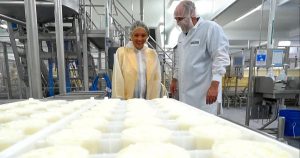
U.S. dairy farmers are pushing back against Canada’s latest attempt to resolve a long-running dispute over milk and cheese imports, accusing trade officials of playing games and flouting treaty obligations.
Canada was forced to change the way it manages dairy imports after an international panel ruled Canada wasn’t making good on its promise to open up more market access under the U.S.-Mexico-Canada Agreement (USMCA), which replaced the North American Free Trade Agreement in 2020. Last week, Canada proposed a new import allocation system in an effort to address the panel’s concerns. But United States producers and exporters say the proposal just swaps one protectionist policy for another.
“Enough is enough,” Jim Mulhern, CEO of the Arlington, Va.-based National Milk Producers Federation, said in a statement, adding that American farmers “are sick and tired of Canada’s game playing on dairy market access.”
A key U.S. achievement in the USMCA was getting Canada to slightly loosen its approach to supply management, a national system that has long antagonized trade partners because it uses prohibitive import tariffs to protect domestic dairy farmers.
Under USMCA, Canada agreed to increase the amount of dairy imports that are exempt from high levies. But U.S. officials argued that Canada violated the agreement by awarding the duty-free dairy — known as tariff-rate quota (TRQ) — almost exclusively to domestic dairy companies, which are more inclined to import bulk quantities of cheap cheese and repackage it into higher-value products for retail, if they use the quota at all. The problem, for U.S. exporters, is that the quota becomes less valuable when it’s used to bring in massive chunks of mozzarella to be shredded and resold as frozen pizzas, rather than fine goat cheese from Vermont.
Late last year, a dispute-settlement panel — the first of its kind under USMCA — found Canada’s TRQ allocation was in violation of the treaty and needed to change. Canada is now proposing a new system that would offer more quota access to distributors, rather than just processors. In the lucrative cheese category, for example, processors used to receive 85 per cent of the TRQs. Under the proposed new rules, 100 per cent of the cheese TRQs would be “allocated to processors and distributors” on the basis of market share.
Nicolas Lamp, a former dispute settlement lawyer at the World Trade Organization who now teaches trade law at Queen’s University, said the proposal appears to still cut out retailers and restaurants, both of which represent a major opportunity for U.S. cheesemakers.
“Why restrict it to distributors?” Lamp said. “Why not simply open it up to anyone who wants to buy U.S. cheese?”
The Retail Council of Canada said on March 8 that excluding grocers would add “unnecessary layers and costs” to the food chain at a time when food inflation is already the highest it has been in more than a decade.
Distributors are concerned that the proposal’s focus on market share means the bulk of the quota will still go to processors, as they control a much larger part of the domestic market. The International Cheese Council of Canada (ICCC), which represents importers, said imported cheese is “barely 10 per cent of total cheeses” sold in Canada.
“It’s geared to basically benefit the domestic processors,” ICCC vice-chair Joe Dal Ferro said on Tuesday.
In the U.S., dairy farmers and exporters are pushing President Joe Biden’s administration to “insist on real reforms” to Canada’s quota system. The proposed changes “will land us in virtually the same spot,” said Shawna Morris, senior vice-president of trade policy at the National Milk Producers Federation and the U.S. Dairy Export Council.
“You still have the same setup, whereby we’re effectively forced to primarily sell to our competitors,” Morris said. “That, in my view, is exactly what the Canadian goal is here, to make it look as if there have been changes made in response to the panel’s verdict without actually changing very much on the ground.”
Morris stressed that U.S. industry isn’t attacking the supply management system, but only wants to make sure that Canada delivers on its promise to provide American producers with a “very limited amount” of access to the dairy market.
“We had a deal,” she said. “We expect both parties to live up to that deal.”
The federal government is running public consultations on the proposal until April 19.

























